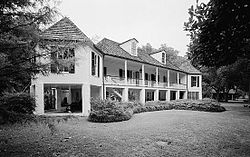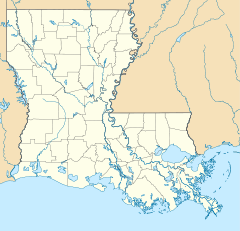- Melrose Plantation
-
Melrose Plantation
 Melrose Plantation
Melrose PlantationLocation: LA 119 off LA 493, Melrose, Louisiana Coordinates: 31°35′59.94″N 92°58′0.09″W / 31.5999833°N 92.9666917°WCoordinates: 31°35′59.94″N 92°58′0.09″W / 31.5999833°N 92.9666917°W Architect: Unknown Architectural style: Colonial, Other Governing body: Local NRHP Reference#: 72000556 Significant dates Added to NRHP: June 13, 1972[1] Designated NHLD: May 30, 1974[2] Melrose Plantation, also known as Yucca Plantation, is a National Historic Landmark in Natchitoches Parish in north central Louisiana. This is one of the largest plantations in the United States built by and for free blacks. The Association for Preservation of Historic Natchitoches owns the plantation and provides guided tours with unlimited photographic opportunities of the main house and its outbuildings. Some early twentieth-century traditions associated with the plantation, such as its first owner and origins of architectural style, have been disproved by historic research since the 1970s, including an archaeological excavation begun in 2001.
Contents
History
In 1974 the National Park Service stated the understanding of the site's significance: "Established in the late 18th century by Marie Therese Coincoin, a former slave who became a wealthy businesswoman, the grounds of Yucca Plantation (now known as Melrose Plantation) contain what may well be the oldest buildings of African design built by Blacks, for the use of Blacks, in the country. The Africa House, a unique, nearly square structure with an umbrella-like roof which extends some 10 feet beyond the exterior walls on all four sides, may be of direct African derivation."[2] Buildings include the main house, the Yucca House, the Ghana House, and the Africa House, plus some outbuildings. The plantation was declared a National Historic Landmark in 1974.[2] In 2008, the state included Melrose Plantation among the first 26 sites on the Louisiana African American Heritage Trail.
Since the 1970s, additional documentary evidence has been found that disproves the asserted identity of the founder. In addition, no evidence has been found to support the tradition that the property was originally named Yucca Plantation. The names attributed to the extant buildings date to early twentieth-century owners' promotion of the plantation as a cultural center. A 2002 study of Creole building practices showed that there was no evidence of African traditions in the architecture. The so-called Ghana House is a simple log cabin type common in the area, and Africa House has been shown to be of design and building techniques similar to French rural structures of the time.[3]
Historical investigations from the 1970s and an archaeological investigation that began at Melrose Plantation in 2001 have uncovered evidence that both confirm some aspects and challenge other elements of local tradition about the complex. Research shows conclusively, through original contemporary records, that the core tract of 911 acres was granted in 1796 to Coincoin's second son, Louis Metoyer, not to Coincoin.
As the children of a white father and African mother, Louis and his siblings were considered multiracial "Créoles of color." Similar to the Metoyer siblings, many multiracial Creoles became educated property owners, particularly in New Orleans, Opelousas, and the Cane River and Campti areas of Natchitoches. Although not legally freed by his white father until 1802, Metoyer evaded Louisiana's Code Noir that prohibited enslaved men from being granted land. This was probably due to his father's wealth and standing.[4][5][6]
Contrary to the 1970s-era assessment of the property, which dated the construction of Louis Metoyer's first residence (Yucca House) to the mid-1790s, review of three land surveys of 1813 show that Louis Metoyer's residence was then south of the Red River (and south of the center of the Melrose complex). It was at the eastern edge of the plantation settled by his elder brother Augustin Metoyer.[7][3] Archeology study of European ceramic ware at the Yucca House site suggests it was first occupied after 1810.[8] Augustin Metoyer and his brother were notable for founding and building the St. Augustine Parish (Isle Brevelle) Church in Natchez, Louisiana, the first in the state built by free people of color.
The plantation is still significant for its long occupancy by the Metoyer family, which was prominent in Isle Brevelle and a strong center of the "Creoles of color" community. Construction began on the "Big House" at Melrose before the 11 March 1832 death of Louis Metoyer.[9] His son Jean Baptiste Louis Metoyer completed the construction in 1833. At J. B. L.'s death in 1838,[10] his $112,761 estate (roughly $2,600,000 in 2007 purchasing power [11]) was divided between his young widow Marie-Thérèse Metoyer and a minor son, neither with any experience in financial matters. Amid the financial depression that followed the Panic of 1837, the mother and son fell heavily into debt. After the mother emancipated the teenaged Théophile Louis Metoyer from the disabilities of minority, creditors filed a series of lawsuits. The Louis Metoyer Plantation went on the auction block.
On 22 March 1847, the Louis Metoyer plantation was struck off at $8,340 to the highest bidder, the French Créole brothers Henry and Hypolite Hertzog, on behalf of their sister Jeanne Fanny (Widow Dassize) Bossier. The Hertzogs and Bossier then operated a cotton plantation, in partnership, until 1880. Like most planters of the region in the wake of the American Civil War and Reconstruction, they struggled financially and were able to do little to improve or maintain the property. (The debtors who sued them included the widow of J. B. L. Metoyer.)
In December 1881, the Metoyer-Hertzog-Bossier Plantation (still unnamed at this point) was sold at auction to satisfy an 1879 judgment rendered against Hertzog-Bossier in Louisiana's Fifth District Circuit. The purchaser, F. R. Cauranneau of New Orleans, held the land and houses as an absentee owner until April 1884, when he found a buyer willing to pay $4,500 cash. The new owner, an Irish immigrant merchant named Joseph Henry, had married into a prominent local family. He gave the property the name Melrose, by which it is still known.[12]
Analysis of glass and nails from the site confirms three major periods of occupancy of Yucca House, c. 1807-1821, c. 1874-1888 (renovation likely after the 1884 purchase by Joseph Henry), and c. 1916-1930 (renovation by Henry's son John and his wife Carmelite "Miss Cammie" Henry). Assessment of remains of European ceramic ware indicates initial occupancy of Yucca House was post-1810, contrary to the 1796 date that historians earlier had proposed.[13]
Because of its strong association with the Metoyer family, Melrose Plantation is the major regional site for National Park Service interpretation of the history of Creoles of color in the region.[14]
- More photos of Melrose Plantation
-
Nearby Cane River Lake
See also
References
- ^ "National Register Information System". National Register of Historic Places. National Park Service. 2007-01-23. http://nrhp.focus.nps.gov/natreg/docs/All_Data.html.
- ^ a b c "Yucca Plantation". National Historic Landmark summary listing. National Park Service. http://tps.cr.nps.gov/nhl/detail.cfm?ResourceId=1231&ResourceType=District. Retrieved 2008-01-31.
- ^ a b Kevin MacDonald et al., 2006, "The Archaeology of Local Myths and Heritage Tourism: the case of Cane River's Melrose Plantation", in R. Layton et al., editors, A Future for Archaeology, London: UCL Press/Cavendish, pp. 131-133.
- ^ Mills, Elizabeth Shown. "Marie Thérèse Coincoin (1742–1816): Slave, Slave Owner, and Paradox," Chapter 1 in Janet Allred and Judy Gentry, ed., Louisiana Women: Their Lives and Times (Athens, Ga.: University of Georgia Press, at press).
- ^ Louis Metoyer Private Land Claim Certificate B1953 (sections 17 and 94, Township 7 North, Range 6 West), Record Group 49, General Land Office, National Archives; Louis Mettoyer claim for 883.60 acres, OPEL: May 1796, File B1953, Louis Metoyer, Opelousas Notarial Records, Louisiana State Land Office, Baton Rouge; Boissier et al. v. Metayer, 5 Mart. (O.S.), 678 (1818)
- ^ Gary B. Mills, "Louis Metoyer," in Dictionary of Louisiana Biography, Glenn R. Conrad, ed., 3 vols. (New Orleans: Louisiana Historical Association, 1988),1:565.
- ^ Gary B. Mills and Elizabeth Shown Mills, Melrose (Natchitoches, Association of Natchitoches Women or the Preservation of Historic Natchitoches), 45
- ^ see Kevin MacDonald et al.
- ^ "Enterrements, 1793-1796 [Etc.]," Section "Annee 1830---," burial date 12 March 1832; Register 15, Church of St. François (present Immaculate Conception), Natchitoches.
- ^ "Enterrements, 1793-1796 [Etc.], burial date 1 October 1838
- ^ "Purchasing Power of Money in the United States from 1774 to 1907," Measuring Worth.
- ^ "Melrose Title Abstract" (source-cited typescripts of original deeds tracing chain of title), compiled by the legal firm Watson, Murchison, Crews, and Arthur, Natchitoches in 1972 for Elizabeth Shown Mills and Gary B. Mills as a starting point for their historic site documentation of the property, commissioned by the Association for the Preservation of Historic Natchitoches; copy held today by E.S. Mills.
- ^ see Kevin MacDonald et al.
- ^ Ibid., p. 140. Its history and lore is also explored in E. S. Mills, Isle of Canes (Provo, Utah: The Generations Network, 2004); and Gary B. Mills, The Forgotten People: Cane River's Creoles of Color (Baton Rouge: Louisiana State University Press, 1976).
External links
- Association for Preservation of Historic Natchitoches - Owner of Melrose Plantation
- "Cane River National Heritage Area", a National Park Service Discover Our Shared Heritage Travel Itinerary
- [1]. Ringle, Ken "Up through Slavery," The Washington Post, 12 May 2002, Life section; archived online
- No Other World, by Norman German, a prize-winning novel praised by Ernest Gaines, fictionalizes the life of Coincoin.
U.S. National Register of Historic Places Topics Lists by states Alabama • Alaska • Arizona • Arkansas • California • Colorado • Connecticut • Delaware • Florida • Georgia • Hawaii • Idaho • Illinois • Indiana • Iowa • Kansas • Kentucky • Louisiana • Maine • Maryland • Massachusetts • Michigan • Minnesota • Mississippi • Missouri • Montana • Nebraska • Nevada • New Hampshire • New Jersey • New Mexico • New York • North Carolina • North Dakota • Ohio • Oklahoma • Oregon • Pennsylvania • Rhode Island • South Carolina • South Dakota • Tennessee • Texas • Utah • Vermont • Virginia • Washington • West Virginia • Wisconsin • WyomingLists by territories Lists by associated states Other  Category:National Register of Historic Places •
Category:National Register of Historic Places •  Portal:National Register of Historic PlacesCategories:
Portal:National Register of Historic PlacesCategories:- Historic districts in Louisiana
- National Historic Landmarks in Louisiana
- Louisiana African American Heritage Trail
- Plantations in Louisiana
- Historic house museums in Louisiana
- Museums in Natchitoches Parish, Louisiana
- Natchitoches, Louisiana
Wikimedia Foundation. 2010.












